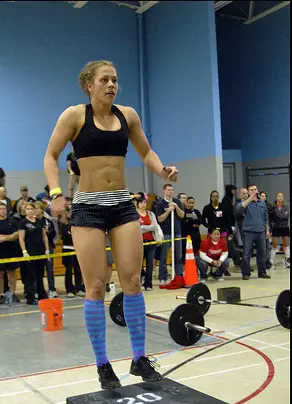
Walk in any CrossFit gym in the country and you are sure to see quite a few people wearing knee-high compression socks. These socks, also popular in the running and triathlon communities, are sold with the promise of improved athletic performance and quicker recovery. But, do compression socks work?
Certainly compression socks have shown great benefit as a means to improve circulation in people who have diabetes or are bedridden due to illness. As blood tends to pool in the lower extremities, the application of graduated compression helps blood return to the heart more efficiently.
But in terms of athletics, what does the science tell us?
Compression Socks Research Studies
Based on the five studies cited below, and a sixth study providing a literature review of compression garments (CG), compression socks can be of benefit. The analysis can be summarized as follows:
- Generally “post-exercise muscle soreness” ratings show improvement with CG’s.
- There is not adequate information regarding sizing and pressure variability to provide to individual athletes.
- Benefits of CG’s during athletic performance may assist in jump performance.
- “During recovery, CGs have had mixed effects on recovery kinetics or subsequent performance.”
- There is research that shows “local blood flow augmentation with compression.”
Cycling Time Trial
A study of 14 trained athletes wearing compression garments during a recovery period created a statistically significant improvement in power output as well as timed performance during a 40-km time trial [1].
Endurance Cycling
In another cycling study, researchers examined the effects of using lower-body compression garments (LBCG) during one hour time trials [2]. Evaluating markers such as blood lactate concentration, VO2, heart rate, and muscle oxygenation, the scientists concluded that “the present results demonstrated limited physiological benefits and no performance enhancement through wearing LBCG during a cycling time trial.”
High Intensity Sprints and Plyometrics
Eleven study participants preformed two trials (separated by 7 days), one with and one without lower-body compression garments [3]. “Participants performed a 10-min exercise protocol of a 20-m sprint and 10 plyometric bounds every minute.” The researchers concluded that compression garments provided limited improvement in recovery and performance; however they did note that muscle soreness following recovery was measurably lower when using compression clothing.
Sprint and 3 km run performance
In a 2012 study evaluating sprint and 3 km run performance [4], 22 male rugby players were “given a full-leg length compressive garment or a similar-looking noncompressive placebo garment to wear continuously for 24 hours after performing a series of circuits developed to simulate a rugby game.” Following a 24-hour recovery period (wearing the clothing), participants were tested using a repeated 40 meter sprint and 3 km run. The results were as follows: sprint times were better by 1.2%, fatigue less by 15.8%, and 3 km times were decreased by 2.0% using compression garments. “Wearing compressive garments during recovery is likely to be worthwhile, and very unlikely to be harmful for well-trained rugby union players.”
Analysis of Compression Garments During Simulated Athletic Competition
In a study using a combination of compression garments and GPS tracking [5], researchers studies “physiological and performance measures in a simulated game-specific circuit for netball. Participants wore either traditional netball clothing, compression clothing or a placebo garment. The finding showed that the athletes were able to go further at faster velocities while wearing compression clothing, but the effects were minimal.
Note: If you’re interested in learning how to read and understand research studies, please read this article about The Scientific Proccess.
References:
1: de Glanville KM, Hamlin MJ. Positive effect of lower body compression garments on subsequent 40-kM cycling time trial performance. J Strength Cond Res. 2012 Feb;26(2):480-6. PubMed PMID: 22240553.
2: Scanlan AT, Dascombe BJ, Reaburn PR, Osborne M. The effects of wearing lower-body compression garments during endurance cycling. Int J Sports Physiol Perform. 2008 Dec;3(4):424-38. PubMed PMID: 19223669.
3: Duffield R, Cannon J, King M. The effects of compression garments on recovery of muscle performance following high-intensity sprint and plyometric exercise. J Sci Med Sport. 2010 Jan;13(1):136-40. Epub 2009 Jan 7. PubMed PMID: 19131276.
4: Hamlin MJ, Mitchell CJ, Ward FD, Draper N, Shearman JP, Kimber NE. Effect of compression garments on short-term recovery of repeated sprint and 3-km running performance in rugby union players. J Strength Cond Res. 2012 Nov;26(11):2975-82. doi: 10.1519/JSC.0b013e3182711e0b. PubMed PMID: 23007487.
5: Higgins T, Naughton GA, Burgess D. Effects of wearing compression garments on physiological and performance measures in a simulated game-specific circuit for netball. J Sci Med Sport. 2009 Jan;12(1):223-6. Epub 2007 Dec 19. PubMed PMID: 18078789.
6: MacRae BA, Cotter JD, Laing RM. Compression garments and exercise: garment considerations, physiology and performance. Sports Med. 2011 Oct 1;41(10):815-43. doi: 10.2165/11591420-000000000-00000. Review. PubMed PMID: 21923201.
